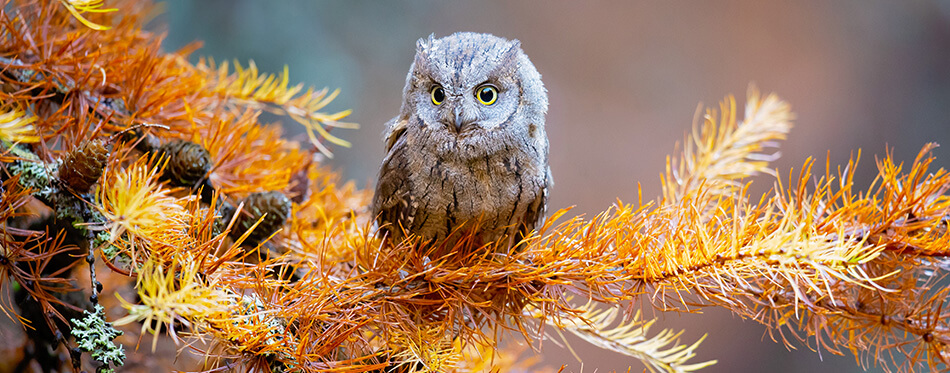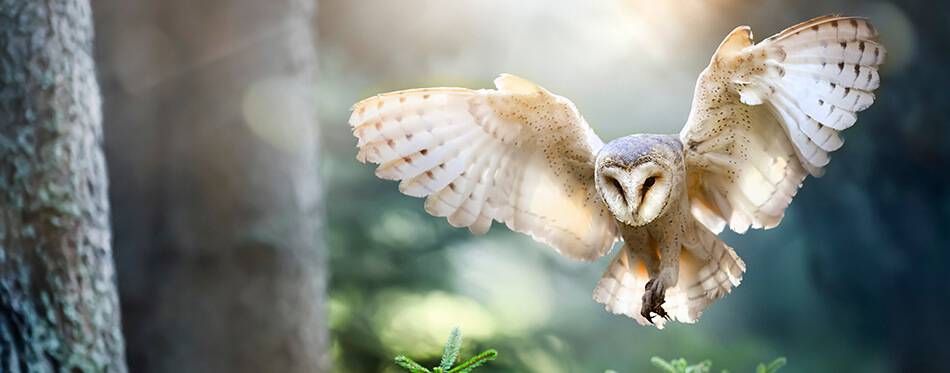Most fans of the Harry Potter series have had that moment when they looked at Hedwig and wondered what it would be like to have a pet owl. In this short guide, we’ll be looking at whether it’s possible to own a pet owl and what it takes to keep owls in domestic settings. We’ll also take a moment to look at which owls are perfectly legal to own and which aren’t.
Which Breeds of Owl Can Be Pets?
Do owls make good pets? Well, that depends on a number of things, including the breed of the owl, whether they can be domesticated, and more. Owls are wild animals, even pet owls still have their wild instincts, and it’s important to recognize that no wild animal will ever be fully domesticated. However, if you’re considering owning an owl as a pet or keeping owls on your land, these species are some of the best owl breeds to bring home:
- Barn owl
- Eurasian Eagle Owl
- Speckled owl
- Spectacled owl
- Mountain Scops owl
- Northern Saw-Whet Owl
- Oriental Bay Owl
Not all owls can be kept as pet birds, and there are various restrictions depending on where you live in the world. That means that, although the above owl breeds may be pets with the right licenses and permits, you may not be able to have them as pets in your country legally. We recommend looking up the local legislation for owl ownership before contacting any rescues or breeders.
Owl restrictions in the States
In the United States, the exotic animal known as the owl can be kept as a pet under certain circumstances. However, you can’t just capture any native owl species and keep it in your home. You need to find specialized breeders and even sometimes have particular licenses before keeping an owl. Also, bear in mind that owls can make bad pets if you don’t have the right environment for them to thrive in. Owls aren’t guinea pigs or cats; they have vastly different needs to other domestic pets.
Facts about owning owls in the USA:
- Private individuals may not legally own an owl as a pet in the United States.
- Any person or organization may not own native owl breeds as a pet. (Snowy owls, for example, are native owls, so you wouldn’t be able to keep one as a pet in America.)
- Native owls are protected under the Migratory Bird Treaty Act.
- You may only keep an owl if you are trained and licensed.
- You may also keep owls for breeding or educational purposes, but you still need training and a license.
The takeaway here is that you can’t own an owl as a pet in the U.S., but you can be trained and obtain a license to keep owls. These owls wouldn’t be pets. Owls kept like this are usually housed in rescues for rehabilitation or because they are endangered. Commercial companies – like owl experience companies – are licensed to keep owls in on a suitable property.
About the Migratory Bird Treaty Act
The Migratory Bird Treaty Act is a piece of legislation passed over one hundred years ago in 1918. Originally, the Act was created to combat issues that stemmed from over-hunting, poaching, and the like. However, bird populations quickly diminished because of the consumption of feathers and other bird features for use in various industries (such as the fashion industry). In the beginning, the Act was simply a treaty between the U.S. and the U.K. to protect migratory birds, but more countries followed suit within a couple of years.
The Migratory Bird Treaty Act makes it illegal to take birds, bird parts, or kill birds unless you have specific permission from the Secretary of the Interior. It also stops people from using bait to capture migratory birds and hunting in certain areas.
The Act only protects native migratory birds, such as native owls, but this is still over one thousand individual species of bird protected by the laws that were put in place so long ago. Though these laws protect most owls, some are not native migratory birds – and, therefore, not protected by this specific Act. They may be protected by other wildlife laws in your country, though. Through our research, we have discovered one breed of owl noted as being unprotected by this Act in the U.S., which is the Spectacled Owl.

Keeping an Owl
Owls are considered exotic animals to have as pets because these wild birds are not typically domesticated. However, if you are outside of America and other countries where there are restrictions on keeping owls as pets, you may be able to own an owl and house them in a typical home setting. For example, there are fewer restrictions in the U.K., and you can own some owl breeds as excellent pets.
Owls commonly kept in the U.K. are Barn owls. They are plentiful and often bred in captivity. As a result, they feature heavily in owl experiences and are found in various wildlife areas around the country.
When deciding to keep an owl, either as a pet or because you are licensed to care for them, you should find relevant information from your local wildlife service and let them know that you are the owner of your owl in case your owl ever goes missing. A lost owl isn’t likely to turn up at your local veterinary practice, after all!
They’ll also need suitable accommodations, and you should consider their dietary and grooming needs. Owls have very sharp talons, and they’re much stronger than they look. An untrained individual isn’t likely to cope with owning an owl, even though they seem like such cool pets to have. They aren’t for novice pet owners.
What do Owls Eat?
When it comes to an owl’s diet, we must first recognize that owls are birds of prey and understand what that means. Birds of prey must kill other animals to survive, and though this doesn’t always mean small mammals, the image of the owl catching the mouse is familiar.
Owls will eat any of the following:
- Insects, including spiders and earthworms
- Fish
- Other birds
- Rodents, like mice and rats
- Lizards
- Snakes
- Small animals, such as rabbits and squirrels
Owls largely adapt to the food available in their habitat, giving them different diets.
Are Owls Dangerous?
Owls are as dangerous as any other wild animal. Though certain bird species may be friendlier and more accepting of human affection, owls will not hesitate to attack humans if they feel they are being threatened in any way. This isn’t Harry Potter, unfortunately, and there are few human-imprinted owls that are happy to let you into their space without warning.. The wild owl can seem very vicious. In a situation where they feel like their safety or the safety of their nest, and young have been compromised, you’ll quickly understand why owls are birds of prey.
That doesn’t mean that an owl will hurt or kill a human. Unsuspecting humans who venture too close to an owl’s nest often escape without injury because the owl in question is more likely to try and scare them away than actually injure them. Fatalities from owl attacks are extremely rare. Humans are very big prey to take on, after all!
If you Can’t Own an Owl
If you don’t have the space or legality to own an owl where you live, there are other ways to witness the habits of these wild creatures. The Great Horned Owl is very common in the United States, and you can find them anywhere in North America. But, we understand that not everyone wants to go out into the wilderness to see an owl to photograph, so…
Places to visit owls in America:
- San Joaquin Wildlife Sanctuary, California
- Cape Coral Friends of Wildlife Annual Owl Festival, Florida
- Georgia Southern University Center for Wildlife Education and the Lamar Q Ball, Jr. Raptor Center, Georgia
- Idaho Bird Observatory, Idaho
- The Red Wolf Sanctuary and Raptor Center, Indiana
- University of Minnesota Raptor Centre, Minnesota
- Owl, Hawk, and Bat Tours in Central Park, New York City
- Cascades Raptor Center, Oregon
- Hawk and Owl Sanctuary, Washington
Please note that this list is not exhaustive, but it does highlight several key locations where you can visit owls around the United States. We’d like to specifically point out the Cape Coral Friends of Wildlife Annual Owl Festival in Florida. This is officially called the “Burrowing Owl Festival”, and it runs every year.
For 2022, it will be running on February 26th in Rotary Park in Cape Coral, Florida. This year celebrates the 20th annual Burrowing Owl Festival, and there will be guided tours, wildlife exhibits, fair food, and more. Burrowing owls are frequently found in Cape Coral, which was created to celebrate.

10 Interesting Facts About Owls
- Owls can almost turn their head the entire way around.
- You cannot hear an owl fly; their flight is completely silent.
- Owls swallow their prey whole and then vomit up the parts they can’t digest.
- Some owls have been known to eat other owls.
- A baby owl is called an “owlet.”
- A mother owl will feed its strongest owlets first, sometimes leaving the others to die.
- Owls have three eyelids. One set for blinking, a second for sleeping, and a third set that keeps their eyes healthy. Cats also have three sets, but most pet owners don’t notice.
- A group of owls is called a parliament of owls or a “wisdom”.
- Some owls bark and hiss.
- Owls hoot to claim their territory and warn off any nearby intruders.
Bottom Line: Do Owls Make Good Pets?
No. Owls prefer the outdoors, and the Migratory Act protects practically every owl species that we’ve outlined in this guide. To own an owl, you wouldn’t own them as a pet. There’s almost no way for someone in the U.S. to have a pet owl without extremely extenuating circumstances. If you wanted to have owls, you’d be looking at setting up some educational area on a reserve for owls to live.
You would need a huge aviary to house them, too. Many owls prefer solitary living, and even those in captivity have their own space. Keeping owls would be an expensive thing to undertake, and these notoriously messy eaters are birds of prey that are mostly strict carnivores. You need to ask yourself if you’re prepared to provide constant fresh meat in otherwise domestic settings and put up with your birds during the breeding season. That’s just the tip of the iceberg, too.
To find out what birds make good pets, we suggest visiting our page 10 Birds That Make Good Pets.
FAQs:
Q: What other birds make good pets?
A: It’s unlikely that you’re going to be able to keep an owl without putting a lot of time, money, and effort into the endeavor. Alternatively, here are some great and very friendly birds that make excellent pets: Cockatiels, Cockatoos, African Gray Parrots, Hyacinth Macaws, Doves, and Green-Cheeked Conures. Any of these birds will be an amazing addition to your home if you’re looking for a feathered friend.
Q: Where can I find a Snowy Owl?
A: You cannot own a Snowy owl as a pet because they are protected native migratory birds. However, if you’d like to view the Snowy owl in all of its majesties, we recommend finding an owl experience day that has a Snowy owl. Snowy owls are native to North America, and they enjoy living in open, treeless areas. You may see them in the wild if you’re around coastlines, marches, or farmland.

